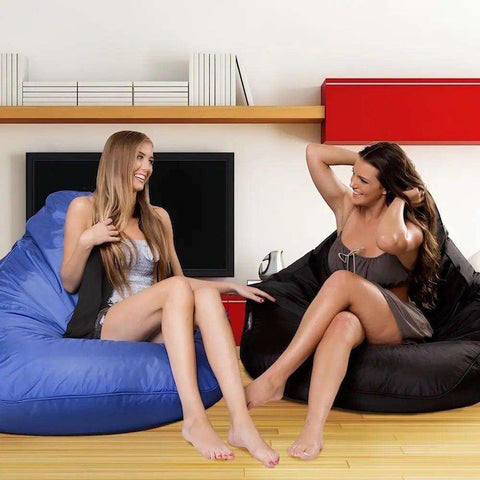If you suffer from dust mite allergies, you likely know the importance of keeping your home as dust-free as possible. Do bean bags attract dust mites?
The first thing to consider when choosing bean bags for allergy sufferers is whether they are dust mite-resistant and easy to clean.
Dust mites are considered among the top triggers of year-round allergies and asthma worldwide. If you suffer from dust mite allergies, you likely know the importance of keeping your home as dust-free as possible. Because dust mites and their debris are typically harboured in upholstered furniture, you may assume that bean bags like the ones sold by Bean Bags R Us aren’t suitable for your home. Like any upholstered item, bean bags can get dust mites; however, they are also remarkably easy to keep dust-free and can be safely used even by those who suffer from dust mite allergies. Read on to find the answers to the question: Do bean bags get dust mites?
What Are Allergies?
Your immune system produces proteins called antibodies that work to protect it from invaders like bacteria, viruses and airborne pollutants. When it detects a foreign substance like pollen, dust mites or pet dander, the antibodies produced by your immune system trigger an inflammatory response in the lungs and nasal passages. This is what is known as an allergic reaction. If you are continually exposed to allergens that your immune system considers to be harmful, like dust mites or dander, this inflammatory response may become chronic. In other words, you may develop an ongoing allergic reaction. This reaction may cause a person to suffer from the unpleasant symptoms of allergies continually, and each person may experience different symptoms or severity. When this occurs, it is regarded as asthma. Asthma is another leading cause of respiratory problems.
What Are Dust Mites?
Contrary to popular belief, dust mites are not insects. Rather, they are arthropods, which means that they are closely related to spiders and ticks. At less than one-third of a millimetre in size, they are not visible to the naked eye and can only be seen under a microscope. White in colour, they have eight legs, and they thrive in temperatures between 20 and 25 degrees Celsius and in humidity levels of between 70 to 80 per cent. These pests absorb humidity for hydration rather than drink it. Dust mites rely on moisture in the air to survive, and higher moisture levels can lead to increased populations. For sustenance, they consume organic matter, particularly dead skin cells, which humans shed in large quantities. Indeed, during the course of a single day, a human may shed up to 1.5 grams of dead skin - more than enough to feed more than 1 million dust mites!
What is a Dust Mite Allergy?
Because they thrive in moist, warm conditions and primarily feed off of dead human skin cells, dust mites tend to live in fabrics that are found around the home. Dust mites can also be found in items like stuffed toys, which can contribute to allergy symptoms. Dust mite allergies aren’t caused by the mites themselves but by the debris that they leave behind in such fabrics, including their faeces and dead bodies. The proteins that are found in this debris are the actual cause of dust mite allergies. This is why some are concerned about the possibility of dust mites being found in things like bean bags.
Risk Factors
Risk factors for developing dust mite allergies include:
-
being a child or young adult
-
having a family history of dust mite allergies
-
Ongoing exposure to dust mites - especially in childhood
Primary Symptoms of Dust Mite Allergies
You may suffer from dust mite allergies if you experience the following symptoms:
-
runny nose
-
sneezing
-
nasal congestion
-
itchy, watery or red eyes
-
itchiness in the throat, nose or roof of the mouth
-
swollen, blue-coloured skin beneath the eyes
-
coughing
-
post-nasal drip
-
facial pressure and pain
These symptoms may vary from mild to severe. If you notice that symptoms persist for more than a week, you should consult your doctor to determine if you have allergies to dust mites. When a dust mite allergy becomes chronic, asthma may be diagnosed as a result. Some of the most common symptoms of asthma include:
-
pain or tightness in the chest
-
whistling or wheezing when exhaling
-
difficulty breathing
-
fits of coughing or sneezing that are exacerbated by respiratory viruses
-
Disrupted sleep quality due to shortness of breath and other allergy symptoms, which can make it harder to get restful sleep
Complications of Dust Mite Allergies
When asthma develops due to a dust mite allergy, exposure to dust mite allergens can exacerbate symptoms. In turn, you may become more at risk of suffering from asthma attacks that require immediate medical attention or even emergency care. Ongoing exposure to dust mites can also cause sinus infections. These occur when the tissues of the nasal passages become swollen, blocking the airways that connect to them, which are otherwise known as sinuses. Chronic inflammation of these passages can increase your risk of developing sinusitis, or an infection of the sinuses.
How Are Dust Mite Allergies Diagnosed?
If you suspect that you may have a dust mite allergy, you should get a referral to an allergist - a doctor who specialises in diagnosing and treating allergies. To diagnose an allergy, an allergist first examines the lining of the nose with a lighted instrument. If the tissues are pale, swollen or even bluish, this could be a sign of an allergy at work. An allergist may also perform the following tests to diagnose a dust mite allergy:
-
Skin Prick Test: The allergist will prick the surface of your skin, usually the forearm, with a needle containing tiny amounts of purified dust mite allergen extracts. After 15 minutes, they will observe the site of the skin prick. If an itchy, red wheal has developed, you likely have a dust mite allergy. The worse this hive-like reaction is, the more severe your allergy to dust mites is.
-
Allergy Blood Test: Also known as an IgE blood test, this screening test may be used if a skin test cannot be performed for any reason. The blood is screened for specific allergy-causing antibodies, and it can also help gauge your sensitivity to them.
Common Treatments for Dust Mite Allergies
Medical interventions may help to treat the symptoms of dust mite allergies. For example, medications like antihistamines and corticosteroids may be prescribed to alleviate symptoms like sneezing; itchy eyes; and the symptoms of hay fever. Decongestants may be used to make it easier for you to breathe. Nasal irrigation is also commonly prescribed for treating the symptoms of dust mite allergies. A neti pot or squeeze bottle can be used to flush mucus and other irritants out of the sinuses, and a saline rinse, or saltwater solution, is used. In the case of severe dust mite allergies, immunotherapy may be prescribed. This is used to ‘train’ the immune system not to react to dust mite allergens. You are exposed to minute doses of those dust mite proteins via once or twice weekly shots. Over the first three to six months, these doses are gradually increased. Maintenance shots are then required every month for a period of three to five years.
Dust mite allergies can be treated with a combination of medications, immunotherapy, and lifestyle changes to help manage and reduce symptoms.
The Best Treatment for Dust Mite Allergies? Avoiding Dust Mite Allergens
Needless to say, most people would rather avoid medical interventions unless absolutely necessary. But if you’re waking up congested, sneezing, or with itchy eyes, it’s worth asking: is your mattress making you sick? Dust mites thrive in mattresses, bedding, and other soft furnishings—making regular cleaning essential. Since dust mites are a fact of life, simply avoiding the fabrics that harbour them and their debris isn’t practical or possible. However, there are many ways to reduce your level of exposure to dust mite allergens. It is essential to eliminate dust mites and their debris to minimise allergy symptoms. Doing this can allow you to live happily without resorting to medications, immunotherapy, or other treatments.
Some of the top ways to reduce dust mite exposure in the home include:
-
Keep humidity levels in check. Dust mites love humidity levels of between 70 and 80 per cent, so it pays to keep levels well below that in your home. An inexpensive device called a hygrometer may be used to assess indoor humidity levels. If they are above 50 per cent or so, devices like air conditioners and dehumidifiers may be used to bring them down to levels that aren’t nearly as appealing to dust mites. Ensure that you monitor and maintain suitable humidity levels in each room, such as the bedroom, living room, and home office, to prevent dust mite infestations throughout the house. That way, you can keep things like bean bag chairs in the home without worrying so much about them becoming infested by dust mites.
-
Vacuum the home regularly. Invest in a high-quality vacuum cleaner with a HEPA filter. Use it to vacuum your entire home on a regular basis thoroughly. If you have a severe allergy to dust mites, you may want to consider having someone else do the work for you, as vacuuming can stir up those allergens and exacerbate your symptoms.
-
Remove dust often. Ditch the feather duster to keep dust from settling around the home. Using something like that can do more harm than good because it often pushes things like dust mite allergens into the air, where they can be inhaled more easily. Instead, use a lightly oiled mop or cloth to wipe down surfaces around the home. Rinse out the mop or cloth regularly as you clean to prevent spreading dust mite debris further.
You should also consider the following:
-
Remove unnecessary things. If possible, remove any carpeting in the home and replace it with hard flooring, such as vinyl or hardwood. Likewise, declutter the house as much as possible to reduce the number of areas for dust to accumulate. Invest in upholstered furniture that can easily be cleaned on a regular basis; bean bag chairs from Bean Bags R Us are excellent examples because they have removable covers that can be cleaned and sanitised with ease. Additionally, consider removing or regularly washing soft toys, such as stuffed animals, from bedrooms to help reduce dust mite allergens.
-
Install a high-efficiency media filter in your HVAC system to improve its efficiency. Reduce the number of airborne particulates in your home, including dust mites and their debris, by installing a high-efficiency media filter in your furnace and air conditioning unit. Ensure that the one you use has a Minimum Efficiency Reporting Value (MERV) rating of 11 or 12. Leave the fan going, and change the filter every three months for best results.
-
Wash fabrics regularly. Dust mites and their debris often accumulate in fabrics around the home, so wash them regularly. Items like bedding should ideally be cleaned every week. Use water that is at least 54.4°C or higher in temperature. If a fabric can’t be exposed to hot water, place it in a dryer at a temperature of 54.4 degrees Celsius or higher for at least 15 minutes. Then wash and dry it as usual. Another option is to place fabrics in freezing temperatures for around 24 hours, which eliminates the dust mites but not their allergens.
Do Bean Bags Get Dust Mites?
Since all fabrics can harbour dust mites and their allergy-causing debris, bean bag chairs, pillows, and other soft furnishings can harbour dust mites. However, by purchasing high-quality bean bags and maintaining them as specified by the manufacturer, you can still enjoy using them in your home even if you suffer from dust mite allergies. The best way to treat dust mite allergies is by eliminating dust mites and their debris wherever you can. Regular washing and cleaning are the best ways to do that. Don't forget to clean all parts of your bean bag regularly, as neglecting these steps can lead to recurring dust mite problems.
Happily, our range of bean bag chairs is designed with ease of care, cleaning, and maintenance in mind. Most include removable covers. Using a dust mite-resistant cover and washing it regularly is important to reduce allergens and prevent infestations. The covers can be hand-washed, machine-washed, or dry-cleaned. The inner lining, which features bean bag beads or pellets, is kept entirely separate.
Bean bags are also popular in school environments, where keeping them clean is essential for children's health. Sitting on infested bean bags can trigger allergy symptoms, so regular cleaning is crucial.
The Role of Memory Foam in Reducing Dust Mites
When it comes to choosing the best bean bags for a dust-free home, memory foam stands out as a smart option for allergy sufferers. Unlike traditional bean bag beans made from expanded polystyrene (EPS), memory foam is a dense, solid material that offers fewer hiding spots and less food for dust mites. Because dust mites thrive in humid areas and feed on dead human skin cells that collect in upholstered furniture, the structure of memory foam makes it much less inviting for these pests.
Bean bag chairs filled with memory foam are especially beneficial for people with severe dust mite allergies. The dense material doesn’t trap dust, dead skin, or other irritants as easily as loose bean bag beans, helping to reduce the risk of dust mite infestations. This means fewer allergy triggers, such as itchy eyes, hay fever, and asthma symptoms, for both adults and children who enjoy relaxing or playing on their bean bag chairs.
To maximise the dust mite-reducing benefits of memory foam, it’s highly recommended to maintain regular cleaning. Wash the bean bag covers and inner lining in hot water whenever possible. Use a HEPA filter vacuum to remove dust and other allergens from the area around your bean bag chair. These steps, combined with the natural resistance of memory foam to dust mites, create a healthier environment for everyone—especially kids who spend long periods sitting, reading, or gaming on their favourite bean bags.
Beyond its allergy-friendly properties, memory foam also provides excellent support and comfort. Whether you’re sitting for a quick break or settling in for a movie marathon, memory foam bean bag chairs contour to your body, making them a fun and comfortable choice for the whole family.
Remember, while memory foam can help reduce dust mites in your bean bag, it’s not a substitute for good cleaning habits. By washing covers on a regular basis and vacuuming with a HEPA filter, you can keep your bean bag chair—and your home—dust-free and enjoyable for everyone, even those with dust mite allergies.
Easy Care Tips
Some easy-care tips for the materials that are found in our most popular bean bag chairs include:
-
Cotton Twill: Our Coco cotton beanbag covers, featuring cotton twill, can be machine-washed or hand-washed. This chair comes with a washing bag that makes it easy to empty it of beads. It can then be washed with ease.
-
Faux Suede: The faux suede found on our Cocoon Suede Bean Bag can be washed by hand, in the machine, or dry cleaned.
-
Linen and Denim: Linen and denim covers, found on our Funky Chairs and Cuba Denim bean bag chairs, can be washed in the machine or by hand.
-
PU-Coated Polyester: Covers made from this material, including those found on our Merlin and Big Boppa bean bag chairs, can be spot cleaned, hand-washed, or machine-washed.
-
Olefin: This high-quality outdoor fabric, featured on top sellers like the Copacabana chair, is sensitive to heat and should therefore be hand-washed and air-dried.
As you can see, you don't have to forgo the fun, comfort and style of bean bag chairs if you suffer from dust mite allergies. Simply clean them on a regular basis to keep them free from dust mites and their debris. You can then enjoy them just as much as anyone else!





